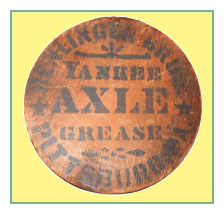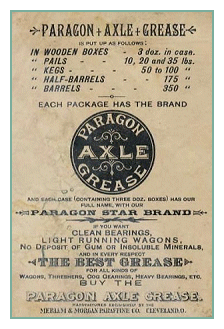axle grease

From the French graisse, Spanish grasa, Italian grasso, and Portugese graxa, a grease for wheels and a distemper in a horse when his fat is melted by excessive action. Fat from a land animal in a soft state, used for lubricating machinery. — Webster, 1882
 McKinley Wheeler, of De Smet, recently spent a few days with frineds on Poverty Ridge. While here he coated more than fifty young fruit trees with axle grease to prevent injury by rabbits. This is an experiment with us, but a writer in a prominent farm journal testifies to its efficiency. — Kingsbury County Independent, December 13, 1907
McKinley Wheeler, of De Smet, recently spent a few days with frineds on Poverty Ridge. While here he coated more than fifty young fruit trees with axle grease to prevent injury by rabbits. This is an experiment with us, but a writer in a prominent farm journal testifies to its efficiency. — Kingsbury County Independent, December 13, 1907
 In William Brannt’s A Pracical Treatise on Animal Fats and Vegetable Fats and Oils (Philadelphia: Henry Carey Baird & Co., 1896), components for axle grease used in winter and summer are given, being a mixture of tallow (beef fat), palm oil, soda, and water. Yellow patent axle grease, such as Charles Ingalls purchased in a flat round box (containers were later made of metal), was a mixture of paraffin oil, spar, calcium hydrate, and rosin oil. Good quality axle grease was the consistency of butter, and was not sticky. The image shows the lid of a “flat wooden box” of axle grease; the background yellow color approximates the color of new grease!
In William Brannt’s A Pracical Treatise on Animal Fats and Vegetable Fats and Oils (Philadelphia: Henry Carey Baird & Co., 1896), components for axle grease used in winter and summer are given, being a mixture of tallow (beef fat), palm oil, soda, and water. Yellow patent axle grease, such as Charles Ingalls purchased in a flat round box (containers were later made of metal), was a mixture of paraffin oil, spar, calcium hydrate, and rosin oil. Good quality axle grease was the consistency of butter, and was not sticky. The image shows the lid of a “flat wooden box” of axle grease; the background yellow color approximates the color of new grease!
A bucket of grease was a familiar sight hanging below covered wagons during Laura Ingalls Wilder’s Little House years. Wheels turning on wooden axles would become dry and squeaky without a frequent application of grease to lubricate them. Road dust and debris would constantly be thrown against the lubricated parts and interfere with the wheel’s action. Caroline Ingalls was creative and able to fashion a light using axle grease and a fabric wick; similarly, early wagon drivers were able to fashion axle grease from common ingredients, as shown below. Note also the newspaper bit above, showing that axle grease was applied to tree trunks to keep rabbits from gnawing at the bark!
Grease for wheel axles. It is now more than twenty years since we employed the following composition, which was revealed to us as a great secret, and for which money has been usually demanded: ‘Thicken half a pint of melted grease with black lead in powder, having previously thrown in and melted a lump of bees-wax of the size of a small hickory nut. Apply it to the hubs and axles before it hardens. By using this composition we have on various occasions driven our carriages two or three hundred miles without once greasing it after we started; and subsequent examinations have satisfied us that no attention of the kind, is necessary on journeys. We add a few precautions. In warm weather, we use tallow in preference to soft grease. — Thomas Emmerson, The Tennessee Farmer (Jonesborough, Tennessee: The Washington Republic Office, 1836), 267.

axle grease (TLW 19; PG), see also button lamp

